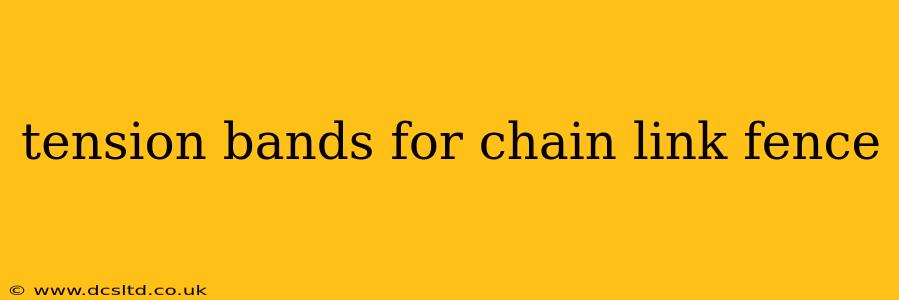Chain link fencing provides a durable and versatile boundary solution for residential, commercial, and industrial properties. However, maintaining its integrity and ensuring a taut, secure fence relies heavily on proper tensioning. Tension bands play a crucial role in this process, preventing sagging and enhancing the overall lifespan of your fence. This guide explores everything you need to know about tension bands for chain link fence.
What are Tension Bands?
Tension bands are metal straps, typically made of galvanized steel or aluminum, designed to clamp onto the chain link fabric and secure it to the terminal posts. They effectively pull the fabric taut, eliminating unsightly sagging and providing a more robust barrier. These bands are essential for maintaining the fence's structural integrity and preventing damage caused by wind or other environmental factors. The strength and durability of the band directly impact the overall strength and longevity of your chain link fence.
How Do Tension Bands Work?
Tension bands operate by using a clamping mechanism to firmly grip the chain link fabric. The bands are attached to the terminal posts using bolts or other fastening systems. By tightening these fasteners, the band pulls the fabric tightly against the post, creating tension throughout the fence line. Proper installation ensures that the tension is evenly distributed, preventing weak points and maximizing the fence's durability.
Different Types of Tension Bands
While the basic principle remains the same, there are variations in tension band designs:
-
Standard Tension Bands: These are the most common type, typically featuring a simple clamping mechanism and a relatively straightforward installation process. They are suitable for most residential and light commercial applications.
-
Heavy-Duty Tension Bands: Designed for applications demanding greater strength and durability, heavy-duty tension bands are thicker and more robust, capable of withstanding significant stress. They're ideal for high-wind areas or locations requiring heightened security.
-
Tension Wire: While not technically a "band," tension wire acts similarly. It's a strong wire strung along the top and bottom of the chain link fabric, then tightened to maintain tension across the fence's length. This requires specialized tools and skill to install correctly.
How to Install Tension Bands
Proper installation is key to the effectiveness of tension bands. While specific instructions may vary based on the band type and fence design, the general process usually involves:
-
Preparing the Terminal Post: Ensure the post is firmly set and plumb.
-
Positioning the Band: Carefully position the tension band around the chain link fabric and terminal post.
-
Tightening the Fasteners: Using the appropriate tools (usually a wrench or socket set), tighten the bolts or other fasteners on the tension band securely and evenly to achieve the desired tension.
-
Inspecting for Sagging: After tightening, inspect the fence section for any remaining sag. Slight adjustments might be needed for optimal tension. Remember, too much tension can damage the fabric, so a balanced approach is vital.
What Size Tension Bands Do I Need?
The appropriate size of tension band depends on the gauge (thickness) of the chain link fabric and the overall height and length of the fence section. Thicker fabrics and larger fences will typically require heavier-duty tension bands. Consult a fencing professional or refer to the manufacturer's specifications for accurate sizing.
How Often Should Tension Bands Be Checked?
Regular inspection is crucial to ensure the continued effectiveness of your tension bands. Check your fence at least once a year, particularly after periods of severe weather. Look for any signs of sagging, loose fasteners, or damaged bands. Prompt repairs or replacements prevent further damage and maintain the fence's structural integrity.
Can I Install Tension Bands Myself?
Many homeowners can successfully install tension bands with the right tools and a little DIY know-how. However, if you are unsure, it's best to consult a professional fence installer to ensure proper installation and avoid potential damage to the fence. Incorrect installation can lead to weak points and a less secure fence.
This guide provides a comprehensive overview of tension bands for chain link fences. Remember, maintaining a taut and secure fence is essential for safety and aesthetics. By understanding the different types of tension bands, their installation, and maintenance requirements, you can help ensure your chain link fence remains in excellent condition for years to come.
